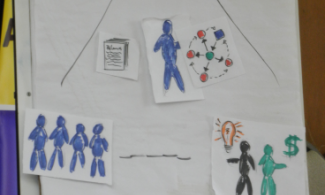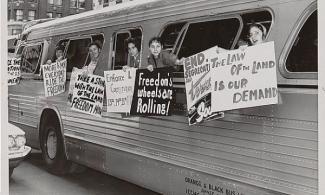Notes from Reviewing "When Workers Decide"
New Society Publishers, an alternate publishing company still thriving, published When Workers Decide in 1992 (WWD). It's a collection of writings on the workplace democracy movement gathered largely from issues of Changing Work, the predecessor of GEO. When I volunteered to take on the task of reviewing it in order to shed some historical perspective on the role and significance of the work GEO has done, I thought it was going to be a rather straightforward task. It didn't turn out that way. Rather, it became something like love letters from the past to now and now to the future.
The depth and complexity of the information in the book was daunting. How it spoke to our second decade here in the 21st century was complex. Realizing what GEO and Changing Work had accomplished in just 30 years, not to mention the 21 years since the book was published, left me quite challenged personally as a current member of the GEO collective. Both publications were there in the fields across the 80s, 90s, and the first decade of this century. That tradition is still here now in 2013 in the form of GEO, and the enormous body of information it holds for all grassroots economic movements. And I am one of the stewards. And this is what I need to live up to in bringing this tradition fully into the 21st!
Aargh!!! Help!!! This is awesome!
Consider what this single collection of writings covered, and you can get an idea of the scope of GEO's chronicling over the past 30 years. Stories of a hundred or so alternative enterprises. The many efforts to develop technical assistance organizations to help advance the development of various kind of democratic workplaces. The efforts to evolve novel ways of funding budding cooperatives. Exploring new kinds of learning necessary for these new kinds of work environments. The labor movement's embracing of worker ownership and how that was playing out back then. How worker ownership without worker control fared. Speculations on new strategies for transforming workplaces. A listing of resources for action. And so on and on....
Today our challenge at GEO is to keep up to par with that kind of work.
Yes. All of us in the various grassroots economic organizing movements should definitely celebrate the 22 years of GEO's chronicling our successes and failures, and the 8 years of Changing Work as well. It is all still invaluable. For example, one of several clear messages that emerges from this particular collection is that then and now the vast majority of American workers aren't that interested in worker ownership, worker control, and taking on the responsibilities that go with such democratic participation. All through the past 30 years we have not made our case to them. This cries out for understanding, deep understanding. The GEO web site holds hundreds and hundreds of stories and articles that can contribute to this kind of understanding.
In many significant ways we could talk about this book as if it were published in 2013, not 1992. The names of the large majority of organizations and firms would be different, but the themes and basic dynamics would be essentially the same. That is not to say that much has not been accomplished in the 21 years separating this book and my reviewing it. For sure, much has. However, that 'much' is far from being enough. Our movement is part of an ongoing effort to reverse a Titanic that's running full steam ahead. Learning how to do this will take generations of experimentation with alternatives and strategies.
Far from being discouraging, understanding our failures is really important for us to learn more and more about what works and doesn't work. This is the kind of knowing that is empowering. Not knowing it and not taking it to heart and to mind, is disempowering. Daniel Boorstein, a historian, makes this painfully clear:
"To try to plan for the future without a sense of the past is like trying to plant cut flowers."
Let's know where we have come from, what we have done, what worked and didn't work, and what is clearly different now than then. This is a real challenge confronting all of us involved in grassroots economic organizing. Think about it this way: if someone in 2033 were to read a similar collection about workplace democracy in 2013, would they have a similar challenging experience as my own in 2013 reading of When Workers Decide?
It is you and I who will determine the answer to that question. Please, let's plant an abundance of fresh flowers over the next 21 years. From reviewing this decade (the 80s) of our history and reflecting on its relevance to us today, I identified several work plots needing special attention and energy:
- chronicling our work steadily, both successes and failures;
- doing research persistently into what has worked and what hasn't, and why;
- growing a movement consciousness continuously;
- grasping the yawning gulf between our movement and the vast majority of American workers; and
- developing the capacity to produce and distribute a penetrating message that "another world is possible."
If space allowed, I could elaborate at some length on each of these needs. Since all five interact dynamically, I can elaborate on one (and this will hint at some of the others): continuously growing a movement consciousness. Why is this so critically important right now as well as back then?
Capitalism, the Titanic we are challenging, is well organized and has enormous leverage to virtually occupy our political system and to keep every significantly effective form of democracy throttled, and not just in the workplace. Challenging this entrenched hold requires large-scale power and coordination. Our movement forerunners in the 80s and 90s represented in this book identified this loudly and clearly. They even voiced concern with how disconnected those particular efforts were from many of the non-economic efforts to strengthen, broaden and deepen democracy in the US. Listen to how Len Krimerman and Frank Lindenfeld described the prevailing condition then:
Sadly, despite the advances it has made in the past two decades…today's democracy-at-work movement remains largely fragmented….union-developed ESOPs in Ohio or Connecticut are disconnected from cooperatively-run print shops, home healthcare enterprises, or recycling firms. In the absence of planning, coordination, and policy making on industry-wide, regional, national, and international levels, the movement would seem to have little chance to effectively oppose the highly centralized forces now in place or even to develop a strong consensus within its own ranks that corporate capitalism should be challenged. ("Taking Stock: Workplace Democracy's Unique Potential for Progressive Change", in When Workers Decide, p. 212)
We are struggling with the same kind of fragmentation today. Grassroots economic organizing efforts across the country don't have anything like a movement consensus around building a broad and inclusive workplace democracy movement. Internationally, Occupy Wall Street spawned a powerful global phenomenon that envigorated a host of political and social movements. In the end it significantly changed the public narrative about what is happening politically and economically, but it has not yet produced ways to build coordinated power.

So our work in this plot would involve:
- Finding the common ground among ourselves for valuing worker-ownership (ESOPS), worker-control, worker-directed co-ops, worker-representation (unions) and seeing how they can all fit together into a coherent movement.
- Figuring out how this work can contribute to building an overall co-operative economy movement involving worker co-ops, consumer co-ops, producer co-ops, and hybrid co-operatives of various kinds, small-scale and large-scale.
- Inviting the many other alternative economic efforts (social enterprises, local currency, intentional communities, etc.) to join in our workplace democracy efforts, particularly at local and regional levels.
- Reaching out to connect all of these alternative economic options (like the Solidarity Economy) with other political and social movements: the environmental movement, the various social justice movements addressing issues such as race, gender, immigration, etc., as well as civic engagement movements such as those promoting community-based deliberative democracy. All of these are dedicated as much as we are to strengthening, broadening, and deepening democracy. Again, focusing particularly on local and regional, levels.
On this last point, Krimerman and Lindenfeld spoke directly to it as well in 1992:
Worker ownership, even if it becomes more widespread, cannot by itself displace or seriously challenge corporate capitalism. For this, it will need outside help. In the apt phrase of Jeremy Brecher and Tim Costello…, it will need to "build bridges" and enter into working coalitions with other progressive groups. ("Drawing In and Reaching Out: Strategies to Strengthen the Workplace Democracy Movement", in WWD, p. 240)
There are major obstacles we would have to deal with in developing this garden. Profound identity problems underlay and drive all of the fragmentation involved. Like I'm a cooperator, not a union man, and the many varieties of this kind of proud isolation. Also, there are staggering problems of time and resources (especially money). Another major factor is the deep cynicism about trusting others to be givers and not just narrowly focused takers.
I came away from my reviewing When Workers Decide more convinced of two basic convictions I already had. One, that if there is going to be a substantial movement that can significantly embed democracy throughout workplaces in the United States, it will have to be a movement committed to strengthening, broadening, and deepening democracy in all its forms. That is, we need to build a culture of democracy to replace our current culture that is so prone to classism, racism, sexism, to "hoeing our own movement row," and to profound deference to established mores.
Two, that we need to root this work primarily in local and regional projects.
This is a challenging agenda, but possibilities for it are being explored. Rather than do a brief summary of one to illustrate this point, let me conclude by referring you to an example where up to 30 diverse organizations are making such a regional effort in NYC. The SolidarityNYC collective, of which I am a part-time member, initiated this effort through a deep listening project. GEO reported on this recently. You can find the final report from this project here.
Forward, with love.
Citations
Michael Johnson (2013). May A Thousand Flowers Bloom: Notes from Reviewing "When Workers Decide". Grassroots Economic Organizing (GEO). https://geo.coop/story/may-thousand-flowers-bloom




Add new comment